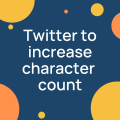The problems at Twitter continue
Sahail Ashraf posted on 13 February 2023
Just when we thought that Twitter couldn’t surprise us, news leaks about a brand new subscription tier.

If we were to outline the rollercoaster ride the platform has been on in just the last month alone, we’d still take up the rest of this post. However, recent events have proved that Musk and his team are still determined to push through and create a platform that continues to chase money.
It’s losing money. In fact, Twitter has been operating at a loss since 2019. Elon Musk came on board and started talking almost immediately about how he was going to turn things around and have a profitable company.
His latest idea seems a little too much for people to stomach though.
The gold standard
Twitter is considering a gold checkmark for brands, as opposed to the old blue mark. While this may seem like a great way to build a little more brand exclusivity, and more reach, it isn’t as simple as that.
The blue mark used to be an exclusive symbol that was genuinely earned by brands. Then it became something you had to pay for when Musk arrived. Now, there is the gold mark. This will cost a little more than $8 a month. In fact, Twitter is considering (it’s really nothing more than an idea at the moment) charging $1000 a month for brands to have the gold mark. That’s $12,000 a year to have a gold mark on a platform that used to offer earned exclusivity.
In a way, it’s a clear attempt at bestowing exclusivity to brands that are rich enough to afford it. So it is a sign of prestige after all. If you can afford it, you are obviously a brand with plenty of cash lying around. And that says that you are exclusive.
Remember the blue check?
The Twitter blue check was a verified badge that was granted to high-profile accounts that were verified to be authentic. It was a quick and easy way for users to recognise the legitimacy of the account and was seen as a sign of trustworthiness and authority for the account holder.
The Twitter blue check was a great way for users to spot and trust the accounts of well-known people, brands, and organisations. It was also an excellent way for Twitter to identify and confirm the authenticity of accounts. To receive the blue check, users had to apply for verification through Twitter’s verification process, which typically required providing proof of identity or verifying that the account belonged to a well-known figure.
Once a user had been verified, their profile would feature a blue checkmark next to their name and profile picture. This was a quick and easy way for users to differentiate between official accounts and fake accounts. It also helped increase the credibility of the account, as users could trust that the information they were receiving was coming from a verified source.
Everything is golden
That was the blue check. Now, if this new direction becomes reality (we doubt it will) brands will have to pay much more than they ever imagined having to if they want that extra level of credibility.
It’s hard to imagine any brand paying that kind of money. Sure, your huge corporations do have that kind of money, but to spend it on what is essentially a subscription to a club is a little too much.
With Twitter losing money alarmingly quickly, and users looking for new options, it will be interesting to see whether the platform is a viable one for marketers in the year ahead. A $12,000 fee suggests it will not.
Are you a social media marketer? Then try out Locowise. The platform allows you to get a handle on your accounts, and make them supersonic when it comes to engagement.






